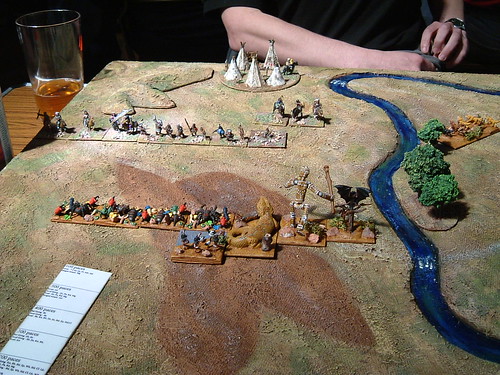Introduction
Basic ideas for this variant are freely nicked from the 5th
December draft of DBA 3.0. They allow variation in terrain which helps prevent the defender from laying cheesy or 'perfect' terrain. I say 'helps prevent' because no mechanism is perfect and I'm sure there are ways to break the system.
Using these rules adds no more than a couple of minutes to the set-up time for the game.
The Mechanism
The defender may choose up to five
pieces of terrain. These may be area features, roads, rivers or a waterway. No
more than one waterway may be chosen, and at least two bad going area features
must be chosen.
 |
| Or you could use a board with pre-set terrain. |
Area features are any bad going
(including steep/rough hills and marshes) and gentle hills. They must be at
least 200 paces across in all directions, and cannot be more than 800 paces
across in any direction. If fields or other cultivation they should be
rectangular, otherwise they should be roughly oval. BUAs can be either. Unless
gentle hills they must be placed entirely within a given battlefield quarter.
No area feature can be placed closer than one element base width from another
area feature or the edge of the playing area.
Roads are as described on Page 12 of HOTT. Roads may cross any
terrain. They must start at a board edge, and end either at a board edge in a
different quarter or at another road, or at a BUA.
Rivers are no more than 200 paces
wide. They must run from one board edge to a different board edge (or to
another river or to a waterway), and cannot go closer than 400p to another
board edge. They must flow through at least two battlefield quarters and cannot
be more than 1 ½ times longer than the distance between their start and end
point. A river may run through any area feature except a hill.
A waterway
represents the sea or a great river. It extends 200-600 paces inwards from an
entire battlefield edge and no more than half its length can be over 300 paces wide.
It can be bordered by a beach or flood plain extending up to 200 paces wide,
which is good going. It may include one island no more than 300p across in any
direction, which must be placed at least 100 paces from the shore.
To
place terrain, divide the battlefield into quarters, numbered 1 to 4. The
defender selects each piece of terrain in turn and rolls a die. On a roll of
1-4 the terrain is placed, or starts, in the corresponding quarter. On a 5 the
defender chooses in which quarter the piece is placed. On a 6 the attacker
chooses in which quarter the piece is to be placed. The defender always chooses
where in the selected quarter the piece is placed. It must be placed if it is
legally possible to do so, but if it cannot be placed then it is discarded.
(The
rules in HOTT for a legal terrain - pieces within 600p of the centre and so
forth - are ignored.)
Once
all terrain has been placed or discarded, the attacker decides their set-up
edge according to the normal HOTT rules.
Big
Battles
The battlefield should still be divided into four quarters for
placement. The defender chooses a minimum number of bad going area features
equal to half of the number of 1200p squares covered by the battlefield, and
the maximum number of terrain features which can be picked is one for each such
square, plus one. Waterways may only be placed along a short edge.
Example:
For a 48AP game the board is made up of six 1200p squares. The defender must
choose at least three bad-going area features, and cannot choose more than
seven terrain pieces in total.

I like the idea of a slightly random terrain system. Restricting the number of terrain pieces to five by itself would stop the worst cheesy excesses. The only downside is that it might stop some non-cheesy but fun terrain placements. Still, HOTT is such a friendly game that I'm sure most people would happily agree to tweaks on the hoof, if asked!
ReplyDeleteI've been using this system for the last four months or so,and it produces some fairly interesting terrain, with about the same density of bad going you get from the setup in the book. What I haven't tried yet it breaking it by going for extreme terrain, such as minimal bad going - it's possible to have no bad going on the board at all, for example (you have to choose some,but positioning of other pieces could prevent it being placed).
DeleteI have tried maximum bad going, and you have to judge the size of the pieces you select carefully. Make them too big and they crowd each other out. Make them too small and you get to place them all, but there will be large areas of open terrain.